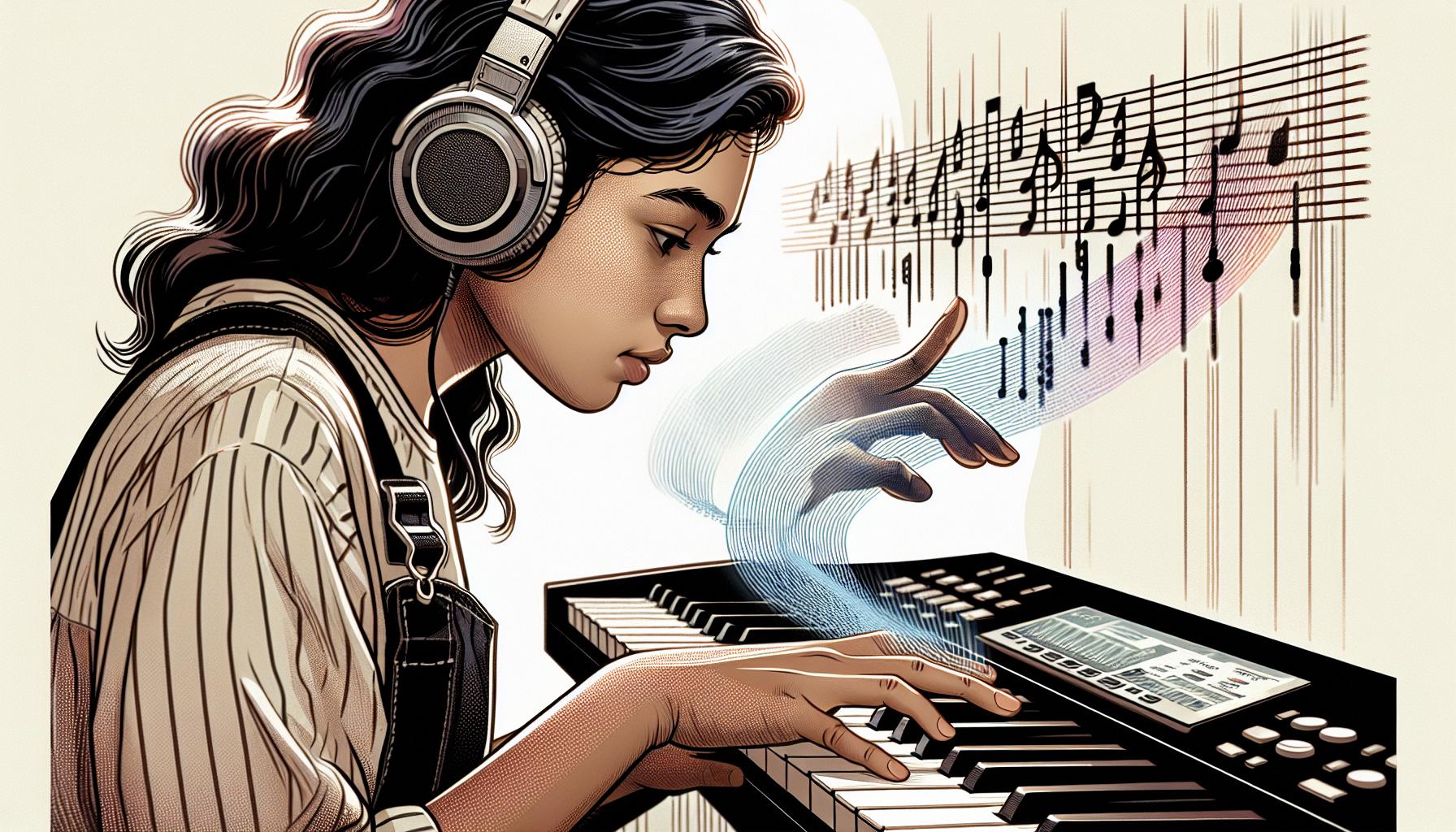Embarking on the journey of learning the keyboard is an exciting adventure, filled with chords, melodies, and rhythms that can express every imaginable emotion. But there's a secret ingredient that can transform a beginner into a maestro: ear training. It's not just about hitting the right notes; it's about understanding and feeling the music in a way that transcends the written score.
For keyboard beginners, ear training might sound like a complex skill reserved for the musically gifted, but that's far from the truth. It's an accessible and essential tool that enhances musical intuition, allowing players to pick up tunes more quickly and play with greater expression. By developing a keen ear, beginners can unlock a new level of connection with their instrument, making every practice session not just a routine, but a journey of musical discovery.
Benefits of Ear Training for Keyboard Beginners
When beginners start their journey in learning the keyboard, they often focus on mastering the mechanics—where to place their fingers, how to read sheet music, and the theory behind the chords. However, ear training adds a valuable dimension to this process, offering several benefits that aren't immediately obvious but are crucial for growth and enjoyment in music.
Enhances Musical Intuition
Ear training transcends the mechanical aspects of playing the keyboard by enhancing musical intuition. Players develop an understanding of music that goes beyond the notes on a page. This includes:
- Recognizing chord progressions
- Identifying intervals and melodies by ear
- Anticipating the direction of a piece of music
Such skills allow keyboard beginners to play more expressively, as they're not just reading music; they're interpreting it. This connection between ear and instrument enables them to convey emotions more effectively, turning their performances into heartfelt expressions.
Accelerates Learning Process
One of the most significant advantages of ear training is its impact on the learning process. With a trained ear:
- Beginners can learn new tunes more quickly.
- Memorization of pieces is enhanced.
- Music theory becomes more intuitive.
Ear training empowers students to hear a song and then play it without needing to search for sheet music, drastically reducing learning time and making practice sessions more fulfilling and fun.
Improves Tuning and Sound Quality
A well-developed ear is critical for achieving good tuning and sound quality. Beginners with ear training can:
- Detect when their instrument is out of tune.
- Understand the tonal qualities of their keyboard.
- Adjust their playing technique to produce a desirable sound.
This ability is essential for those who aspire to perform for others or record their music.
Fosters Creativity and Improvisation
Perhaps one of the most exciting benefits is how ear training fosters creativity and improvisation. With a keen ear, beginners can:
- Experiment with new sounds and styles.
- Compose their music.
- Improvise when playing with others.
This creative freedom not only keeps the learning journey interesting but also helps in developing a unique musical voice.
- Picking up tunes by listening.
- Deciphering complex rhythms and
Developing Musical Intuition through Ear Training

Ear training is not just about sharpening one’s ability to identify notes and chords; it's fundamentally about nurturing a deep-seated musical intuition. For keyboard beginners, developing this intuition can significantly change how they interact with music, transforming them from mere players into true musicians.
Musical intuition refers to the ability to understand and feel music in a way that goes beyond the written notes. It’s about anticipating harmonic progressions, sensing rhythmical shifts, and feeling the emotional undertone of pieces—all without needing to consciously analyze them. Such intuition empowers musicians to make spontaneous and emotionally resonant decisions in their playing.
One of the primary ways ear training boosts musical intuition is by helping beginners to internalize the language of music. Just as we learn to speak by listening, musicians learn to express themselves by developing an acute ear for musical patterns and nuances. Ear training drills that focus on recognizing intervals, chord qualities, and scales lay the groundwork for this internalization. They help beginners to not just play notes, but to understand their relationship and emotional weight within a piece.
Another aspect of developing musical intuition through ear training involves learning to listen actively. Active listening entails more than hearing sounds; it's about dissecting and understanding them. When keyboard beginners practice listening to a wide range of music and focus on identifying its components, they gradually enhance their ability to predict musical directions and express them through their playing. This skill is invaluable for improvisation and composition, where making quick and informed musical choices is paramount.
Here’s a brief look at how ear training impacts different areas of musical expertise:
| Aspect | Impact of Ear Training |
|---|---|
| Harmony Recognition | Facilitates understanding of chord progressions and structures |
| Rhythm Perception | Improves timing and syncopation skills |
| Melodic Ear | Helps in identifying and recreating melodies and tunes |
| Tonal Memory | Enhances ability to remember and reproduce musical pieces |
By engaging in regular ear training exercises, beginners start to feel the music intuitively. They learn to anticipate changes and recognize patterns, which allows them to play more freely and expressively. Moreover, as their musical intuition grows, so does their confidence, enabling them to explore new musical territories without fear.
Techniques for Improving Ear Training Skills

Improving ear training skills is a journey that requires patience, practice, and the right techniques. For keyboard beginners, mastering these skills opens up a world of musical possibilities, allowing them to connect more deeply with their instrument. Below are several effective strategies that students can incorporate into their daily practice routines to enhance their ear training skills.
Interval Recognition Practice
One of the foundational aspects of ear training is the ability to recognize intervals—the distance between two notes. Beginners should start with simple intervals, such as major and minor seconds, and progressively work their way up to more complex intervals. Apps and online resources offer interactive exercises that make this practice both fun and educational. Listening to a wide variety of music and attempting to identify the intervals used can also boost one's ability to recognize intervals in real-time.
Singing While Playing
Incorporating singing into keyboard practice sessions is an invaluable technique for improving ear training skills. Singing the notes as they play them helps students internalize the sounds of the intervals and chords, fostering a deeper musical understanding. This method also helps with pitch accuracy and rhythm, as students learn to match their voice with the keyboard's notes.
Chord Quality Recognition
Understanding and identifying different chord qualities is another important aspect of ear training. Beginners should familiarize themselves with the sound of major, minor, augmented, and diminished chords. Practicing chord progressions and listening to music to identify the chord qualities being used helps reinforce this knowledge. Students can also use music theory apps or online games that focus specifically on chord recognition exercises.
Active Listening Exercises
Active listening is a critical skill for any musician. Beginners should spend time listening to music with the intent of dissecting and understanding its various components. This means focusing on identifying the melody, harmony, rhythm, and any unique qualities of the music. Analyzing pieces from different genres expands one's musical vocabulary and helps in developing a keen ear.
Recording and Review
Recording oneself playing and then reviewing the recording can offer invaluable insights into one's playing and listening abilities. This exercise allows students to critically assess how well they're able to reproduce what they hear and identify areas for improvement. It also helps in developing self-critique skills and enhances one's ability to listen critically.
By integrating these techniques into their practice routines, keyboard beginners can significantly improve their ear training skills. It's important for students to be persistent and patient, as developing a finely tuned ear is a gradual process.
Integrating Ear Training into Keyboard Practice

Integrating ear training into daily keyboard practice is a seamless strategy for beginners to enhance their musical understanding and listening skills simultaneously. By blending these exercises, beginners not only learn to play the instrument but also develop a sharper ear for music nuances.
Start with the Basics
For beginners, starting with the basics is crucial. They should begin with simple drills such as identifying single notes and gradually move to more complex tasks like recognizing chords and intervals by ear. Here's how they can incorporate these exercises:
- Single Note Recognition: Play a note on the keyboard and try to identify it without looking. Repeat this with different notes, preferably in a random order, to challenge the ear.
- Interval Training: Play two notes consecutively or simultaneously and identify the interval. Start with basic intervals and progressively include more challenging ones.
Integrating these exercises for at least 10 minutes at the beginning of practice sessions helps in warming up the ears for the upcoming practice.
Application in Songs
Applying ear training skills in learning songs is an effective way for beginners to experience real-time benefits. They should:
- Choose a simple melody or song they're familiar with.
- Attempt to play it by ear, starting with the melody line before moving on to the accompanying chords.
- Use trial and error to find the correct notes and chords, relying on their ears to guide them to the right sounds.
This practical application strengthens their ability to learn music more intuitively and builds confidence in their ear training progress.
Active Listening Sessions
Incorporate active listening into practice routines by setting aside time to listen to music with a critical ear. Here's a structured way to approach it:
- Select a piece of music and listen for the melody, rhythm, and harmony.
- Focus on identifying the intervals and chord progressions used in the piece.
- Try to replicate parts of what they've heard on the keyboard.
Active listening sessions enhance auditory skills and provide practical examples of how musical elements come together in compositions.
Recording and Self-Assessment
Beginners should regularly record their practice sessions, especially the parts where they’re applying ear training skills. Listening back to these recordings allows them to:
- Assess their accuracy in pitch, rhythm, and chord recognition.
- Identify areas of improvement and adjust their practice accordingly.
Recording serves as a valuable tool for self-assessment and tracking progress in ear training.
Mastering Keyboard Skills through Ear Training

Ear training isn't just an isolated aspect of learning the keyboard; it's a Critical Pathway to mastering keyboard skills. For beginners, the journey of becoming proficient at playing the keyboard intertwines with the ability to listen carefully and respond musically to what they hear. This synergy between playing and listening sharpens overall musicality, making ear training an indispensable part of keyboard education.
To effectively enhance keyboard skills through ear training, they should start with the basics. Recognizing pitches and intervals by ear lays a foundational understanding, enabling beginners to play melodies and harmonies more intuitively. As they develop these core listening skills, beginners will find it increasingly easier to replicate songs and compose their own music, relying less on visual aids like sheet music.
Another significant aspect involves Rhythmic Training. Just as recognizing pitches is crucial, understanding and internalizing rhythms is equally important. Beginners should practice clapping or tapping out rhythms they hear, progressing from simple beats to more complex rhythmic patterns. This practice not only improves timing and coordination but also aids in developing a keen ear for different rhythmic structures, essential for nuanced keyboard playing.
Incorporating ear training into keyboard practice doesn't have to be tedious. Here are some practical tips to make it engaging:
- Use Technology: There are numerous apps and online resources designed to improve listening skills. These can make ear training exercises more interactive and fun.
- Play By Ear: Challenge themselves to learn their favorite songs by ear. Start with simple tunes and gradually work up to more complex pieces.
- Imitate Sounds: Attempt to mimic various sounds on the keyboard. This could be anything from a doorbell to the melody of a bird's song, encouraging flexibility and creativity in their playing.
Developing a reliable ear for music also involves critical listening to recordings. They should listen actively, trying to identify and separate different musical elements such as melody, harmony, rhythm, and timbre. Beginners could also benefit from trying to transcribe these elements, though this may require some more advanced ear training.
Practice is key in ear training just as with any other skill. Beginners should aim to integrate listening exercises into their routine, however brief these sessions may be. Over time, consistent practice will significantly enhance their ability to play by ear, understand music theory, improvise, and interpret music more expressively on the keyboard.
- Improved
Conclusion
Ear training is a gateway to unlocking the full potential of keyboard playing for beginners. It's not just about hitting the right notes; it's about understanding and feeling the music deeply. By incorporating ear training exercises into their practice routines, beginners will find themselves more in tune with the music they create and enjoy. They'll not only play more accurately but also with greater emotional expression. So, let's embrace ear training as a vital component of learning the keyboard. It's a journey that promises to enrich one's musical experience profoundly.
Harlan Kilstein began playing piano during covid with no piano background at all. He taught himself how to play learning what to do and what not to do.
Today he's an advanced intermediate player and can help you grow in your skills because he learned all this on his own.








